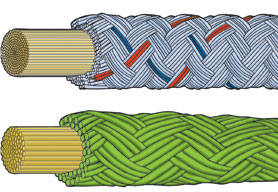|
|

Understanding String Construction
By Steve Crandall
Vice President, Sales & Marketing
Ashaway Racket Strings
 |
Ashaway’s MicroLegend string -
a microfilament-cored model. |
Ashaway’s Rally string -
a multifilament-cored model.
|
Any badminton racket can be "tuned" to provide more power, more control, or greater durability by selecting a racket string that has been designed to optimize one or more of these characteristics. In order get the best performance out of your racket, therefore, you have to understand differences in string construction.
There are, of course, two main types of string: natural gut and synthetics. Gut string is made from very thin strips of beef intestine, chemically treated and twisted together. It has some benefits over synthetics in terms of "touch" and responsiveness. But because it is made from natural fibers, it absorbs humidity from the air, and it can lose tension somewhat unpredictably. It also tends to be much more expensive, and somewhat less durable than synthetics, which explains why few American players use it.
Synthetic strings are made from nylon, a material that can be either stiff or resilient, depending upon the string maker’s choice of a specific polymer. Manufacturers may combine yarns made from different nylon formulas into a single string, to achieve just the right balance of properties.
Synthetic strings have two major components. The core, the central load-bearing member, provides strength, determines the string’s stiffness or resiliency, and is the source of the string’s power. The jacket, or wear layer, protects the core from abrasion, and adds texture to the surface, which aids in control.
There are three types of cores: monofilament, multifilament and microfilament. A monofilament core is a single, relatively heavy fiber, similar to monofilament fishing line. This tends to be rather stiff when used in a thin string, which explains why monofilament has largely fallen out of favor in badminton. Monofilament strings are still popular in tennis and racquetball, however, where this stiffness can be desirable.
Multifilament cores are made from thousands of thin fibers twisted together, but still free to stretch somewhat independently from one another-somewhat like the fibers in natural gut string, but without its liabilities. This produces a string with great resiliency and power.
Microfilament cores are made from even thinner fibers than those found in multifilament cores. In fact, the microfilament core results in a string which is up to 10 percent thinner. A thinner string causes less wind resistance, allowing the shuttlecock to be hit harder and faster.
Microfilament construction yields a string with greater stretch capacity and power, but with no loss of strength.
The jacket, or outer wear layer, provides the string’s main abrasion resistance and control characteristics. Jackets may be either twisted or braided over the core. Twisting creates a somewhat smoother surface, making it easier to string in the racket. Braiding produces a more textured surface, for more "bite" on the shuttlecock.
As the racket contacts the shuttlecock several hundred times during a match, the cross strings are pounded against the main strings, slowly cutting notches into the mains. When a fiber in a twisted jacket breaks due to "notching," it begins to unravel, and the string deteriorates quickly with further use. In a braided cover, however, the over-under-over design locks the fibers together, so the breakage of a single fiber doesn’t mean the imminent death of the string. In fact, many jacket fibers may break and the string will remain intact. Eventually, of course, even braided jackets become so worn they can no longer protect the core.
To choose the right string for your racket, first decide which basic core and jacket types are appropriate for your style of play and your wallet. Identify the strings that have the core-jacket combination you’re looking for, then compare several models through play-testing to find the one that feels right for you.
This article previously appeared in USA Badminton.
|